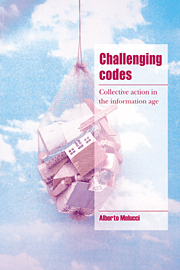Book contents
- Frontmatter
- Contents
- Preface and acknowledgements
- Introduction
- Part I Theory of collective action
- Part II Contemporary collective action
- 5 Conflicts of culture
- 6 Invention of the present
- 7 The time of difference
- 8 Roots for today and for tomorrow
- 9 A search for ethics
- 10 Information, power, domination
- Part III The field of collective action
- Part IV Acting collectively
- References
- Index
7 - The time of difference
Published online by Cambridge University Press: 23 November 2009
- Frontmatter
- Contents
- Preface and acknowledgements
- Introduction
- Part I Theory of collective action
- Part II Contemporary collective action
- 5 Conflicts of culture
- 6 Invention of the present
- 7 The time of difference
- 8 Roots for today and for tomorrow
- 9 A search for ethics
- 10 Information, power, domination
- Part III The field of collective action
- Part IV Acting collectively
- References
- Index
Summary
Women's voices and silences
More than any other contemporary movement, the women's movement has interwoven reflection on the female condition with its conflictual role within society; and more than any other it has based its collective action on an appeal to difference. Because it is rooted in the ancestral experience and nature of the species, this difference is irreducible; and this is why it is so difficult to disentangle women's struggles from the history of womanhood itself – from the awareness of a subjugation imbibed into the most archaic memory of human societies. Be that as it may, we must again resort to the method outlined above: our analysis must distinguish between the female condition and the women's movement; it cannot deduce one from the other.
Women have for a long time struggled for the equality of opportunities, and this struggle based on the common biological and historical condition has also helped focusing collective energies against an external enemy (Evans 1980; Rupp and Taylor 1987). But from the 1970s on, the women's movement has moved on to follow different routes in pursuit of its goals (Freeman 1975; Buechler 1990; Ryan 1992); similarly, reflection on woman's condition has also concentrated on the plurality of the modes and meanings of being a woman (Chodorow 1978; Gilligan 1982; Fraser 1989; Skevington and Baker 1989; Lorber 1994). Mutated by time, diversified by social membership and life-course, the female condition is today even more strikingly marked by difference.
- Type
- Chapter
- Information
- Challenging CodesCollective Action in the Information Age, pp. 133 - 144Publisher: Cambridge University PressPrint publication year: 1996

